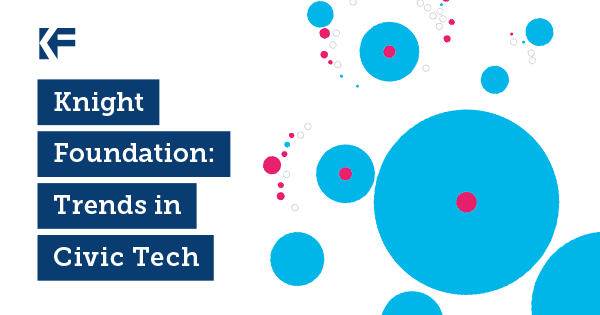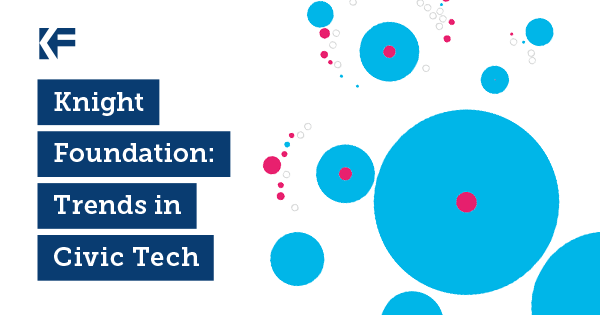
Urban neighborhoods take small steps into ‘civic tech’
Above: Dionne Baux, lead program officer for Open Gov for the Rest of Us, provides some over-the-shoulder instruction at a tech event in the Englewood neighborhood. Photo credit: Gordon Walek.
Knight Foundation’s recent release of “The Emergence of Civic Tech: Investments in a Growing Field” put a nifty title on the disparate activities that use digital tools to improve communities. Even better were the data visualizations that showed money flowing into areas that resonate in our field of community development, including peer-to-peer sharing, community organizing, neighborhood forums and information crowdsourcing.RELATED LINKS
“Pulling back the curtain on civic tech” by Jon Sotsky on Knight Blog
“New tools produce better understanding of investments in civic tech” by Sean Gourley on KnightBlog
“The Emergence of Civic Tech: Investments in a Growing Field” on Slideshare.net
“Civic Tech Directory.xslx,” a landscape list of civic technology projects by Jon Sotsky
“Knight Foundation’s civic tech report: why it matters” by Tom Steinberg on KnightBlog
“Strange bedfellows or yin and yang” by Stacy Donohue on KnightBlog
“Civic tech report helps ID opportunities in the field” by Keya Dannenbaum on KnightBlog
But while the Knight database highlights bigger enterprises, the neighborhood work that we support in Chicago is typically small and done on a shoestring. These efforts take place not in the hipster districts or downtown tech clusters, but in neighborhoods where incomes, education and Internet usage tend to be low. They represent small but important steps by less-connected neighborhoods to enter the high-tech world. For example:
- Greater Southwest Development Corp. built a mile-long wireless corridor, bringing free Internet service to businesses and residents via 17 rooftop access points.
- The Chinatown Chamber of Commerce is experimenting with texting to distribute coupons and other incentives that support businesses and events.
- The Resurrection Project works with tech-curious residents to advance its crowd-sourced Pilsen Portal, and to introduce Open Gov tools and data.
- LISC Chicago is using the database Wufoo to track thousands of interactions by Obamacare health-insurance navigators.
“Our neighborhood is basically not online and not engaged with the Internet,” said Tina James of the Greater Southwest Development Corp. at a tech-focused Commercial Roundtable Lunch. “Many of our business owners don’t know a lot about computers, are scared of technology, and don’t have access to the Internet.”
That’s why Greater Southwest built its wireless corridor, using funds from a LISC grant and a special tax on local businesses, and why it sponsored a five-week tech boot camp that helped a few small businesses jump to computer bookkeeping, Internet use or online credit-card processing. “To me,” said James, “that is a big tech win.”
Peer sharing
Much learning comes from peer-to-peer sharing among neighborhood innovators. At the business lunch, Yin Kean of the Chinatown Chamber of Commerce opened with a simple yet powerful demo of text messaging.
“In our neighborhood, the mobile phone is often the best way to reach people,” she said. To share her contact info, she asked participants to text YinKean to 28748; within seconds, her info was texted back. (Go ahead; try it.)
Two others built wireless networks to meet local needs. It can cost $30,000 or more to bring fiber into the Stockyards Industrial Park from nearby arterial streets, said Roger Sosa of the Back of the Yards Neighborhood Council. So his group contracted with Business Only Broadband to beam in the service and signed up customers including Testa Produce, which had recently invested $24 million in a new facility. The wireless service came with no capital costs and rates well below comparable service from telecom firms – $250 to $500 per month depending on speed. The other network was built by AR Designs Inc. to provide service to residents of a mixed-income housing development.
Gaining data skills
Gaining tech and data skills is neither an easy road, nor a quick one. A 2011 assessment of LISC’s nonprofit partners found that most lacked the time, expertise and resources to use tech and data in meaningful ways. Many had antiquated hardware and software and lacked technical skills.
In response, LISC and partners have been methodically ramping their capacity, using multiple neighborhood projects to spread skills around. LISC’s network of 13 Centers for Working Families routinely captures data about participants and is in the midst of a database upgrade. Partners in the Smart Communities program taught thousands how to use the Web and are now introducing public data sets, thanks to a Knight grant for Open Gov for the Rest of Us.
The latest? LISC and 21 partners are using Wufoo to track Obamacare health outreach. The tool was configured by the civic-tech organization Smart Chicago Collaborative so that navigators could easily input data from mobile devices or computers. By December, they had logged 9,300 interactions and knew that 30 percent of participants preferred contact by text message, and that 43 percent of interactions involved español.
“In Chicago, we’ve got the best minds and hearts in community development,” said LISC Executive Director Susana Vasquez, “and we’ve got the best minds and hearts in civic tech, too. When you put those two together, that’s where real innovation happens.”
Writer Patrick Barry works for LISC Chicago to document its work in open government, technology and community development.
Recent Content
-
Community Impactarticle ·
-
Community Impactarticle ·
-
Community Impactarticle ·



